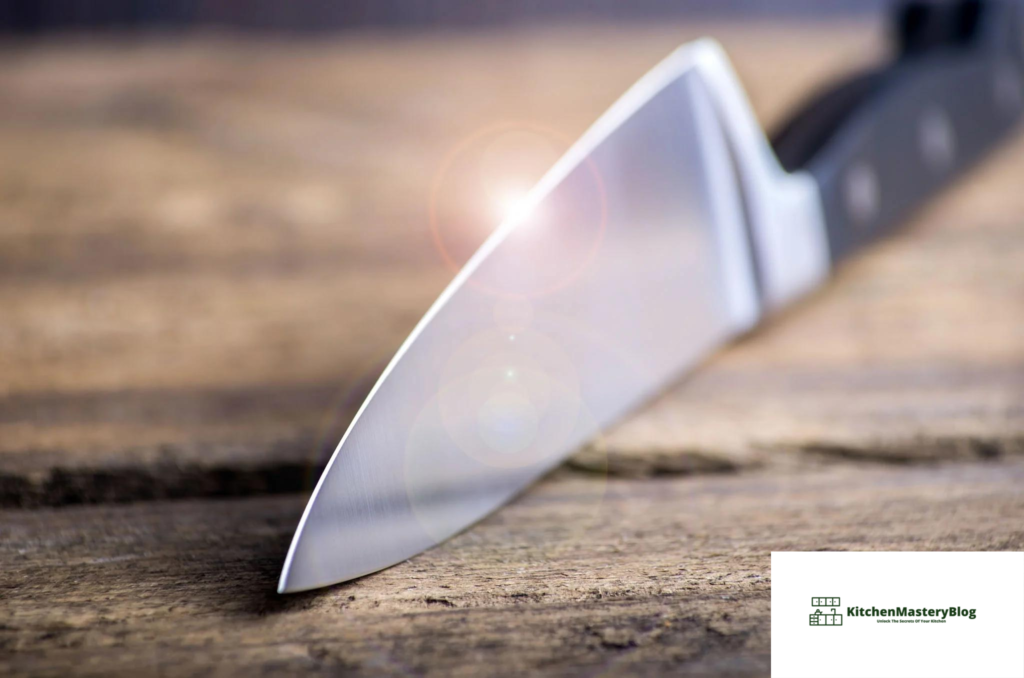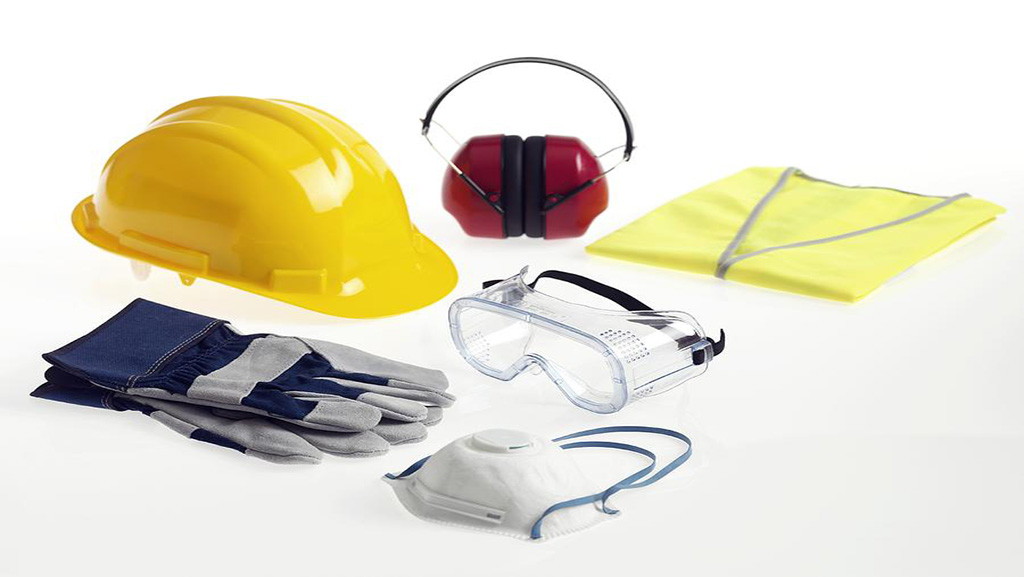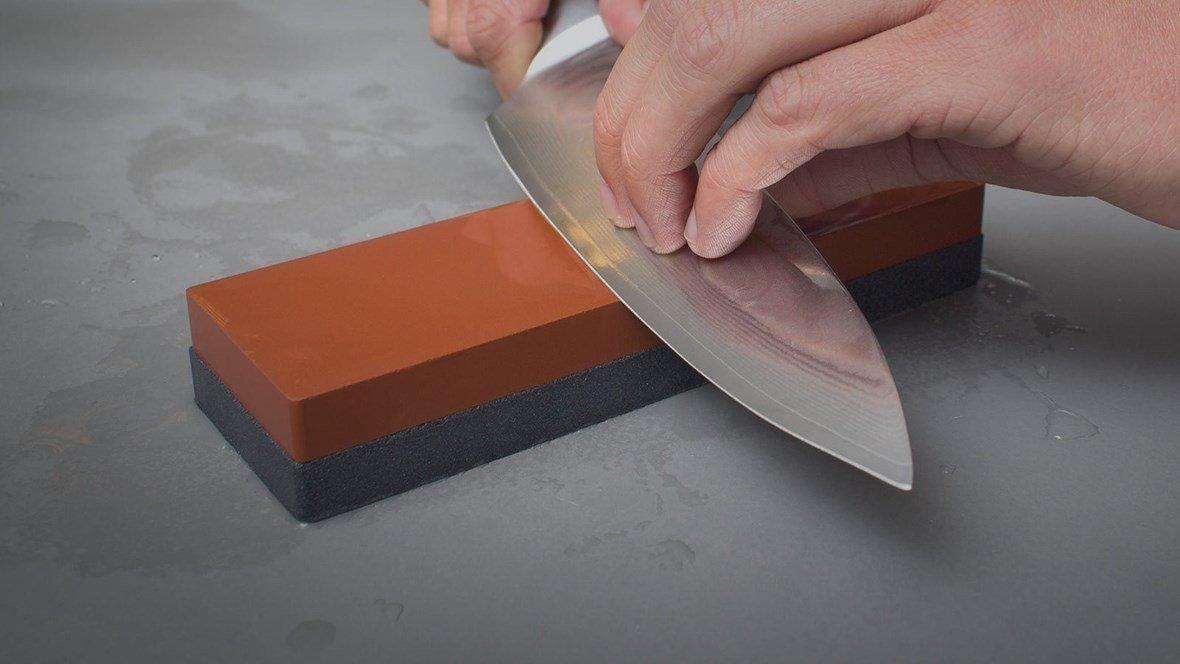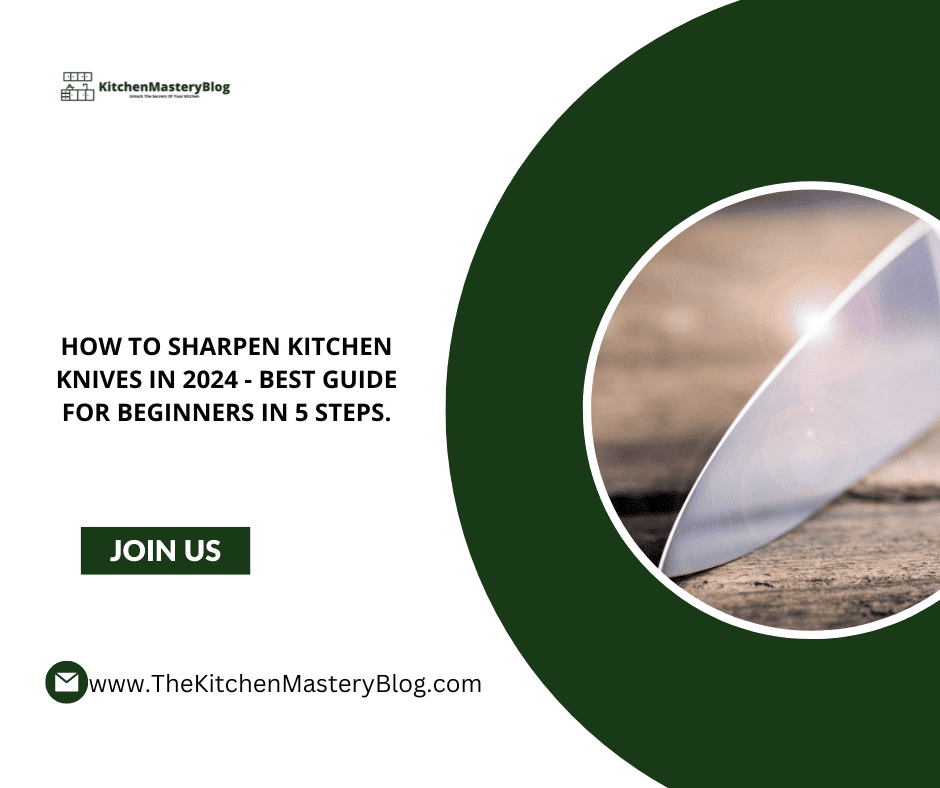
Ever Wonderd About A Blog On How To Sharpen Kitchen Knives? Look No Further!
How To Sharpen Kitchen Knives In 2024 Overview
1. Understanding the Importance of Sharp Kitchen Knives

In any kitchen, whether it’s a professional setting or your cozy home space, the significance of sharp kitchen knives cannot be underestimated.
The phrase “how to sharpen kitchen knives” stands as the cornerstone of culinary expertise. Let’s delve into why maintaining sharpness in your kitchen knives is essential for every cooking enthusiast.
- Efficiency in the Kitchen: Picture this – you’re trying to slice through a ripe tomato, but instead of a clean cut, you end up squishing it. A sharp knife makes every task easier and quicker. It effortlessly glides through ingredients, saving you time and effort.
- Safety First: Contrary to popular belief, a dull knife is more dangerous than a sharp one. When you use a dull knife, you’re more likely to apply excess force, increasing the risk of slips and cuts. On the other hand, a sharp knife requires minimal pressure, reducing the likelihood of accidents.
- Precision Cutting: Whether you’re finely chopping herbs or dicing onions, precision is key in cooking. Sharp knives provide the control and accuracy needed for intricate cuts, resulting in evenly cooked dishes and beautifully presented meals.
- Maintaining Food Quality: Ever noticed how vegetables tend to oxidize faster when roughly chopped? Sharp knives minimize cell damage, preserving the freshness and flavor of your ingredients. This is especially crucial for delicate items like herbs and fruits.
2. Essential Tools and Materials for Sharpening Kitchen Knives

When it comes to mastering the art of sharpening kitchen knives, having the right tools and materials is crucial. In this segment, we’ll explore the essential equipment needed to achieve razor-sharp blades. Let’s dive in!
- Sharpening Stones: A sharpening stone, also known as a whetstone, is the cornerstone of knife sharpening. These stones come in various grit levels, ranging from coarse to fine, allowing you to adjust the sharpness of your blades.
- Honing Steel: Contrary to popular belief, honing steel doesn’t sharpen knives; it helps maintain their sharpness by realigning the blade’s edge. This tool is essential for regular maintenance between sharpening sessions. If you’re considering honing steel as a tool for maintaining your kitchen knives, we’ve compiled a comprehensive guide for you.
- Discover the top five best honing steels in our latest blog post, where we break down their specifications, benefits, and drawbacks. Dive into our recommendations by clicking here:
- Knife Sharpener: Electric or manual knife sharpeners are convenient options for quick touch-ups, especially for those new to sharpening knives. For those interested in exploring electric knife sharpeners, we’ve got you covered.
- Check out our blog post on the top five best electric knife sharpeners, where we delve into their features, pros, and cons to help you make an informed decision. Click here to read more:
- Lubricating Oil or Water: When using sharpening stones, lubricating oil or water is necessary to facilitate the sharpening process and prevent the stone from clogging with metal particles.
- Cleaning Supplies: After sharpening your knives, it’s essential to clean them thoroughly to remove any metal shavings or debris.
- Safety Gear: Last but not least, safety should always be a priority when sharpening knives. Encourage readers to use safety gloves and goggles to protect their hands and eyes from potential accidents.

3.Step-by-Step Guide: Sharpening Your Kitchen Knives
Sharpening kitchen knives is an essential skill for every cooking enthusiast. In this step-by-step guide, we’ll walk you through the process of how to sharpen kitchen knives effectively. Follow these simple steps to ensure your blades are always razor-sharp and ready for any culinary task.
- Gather Your Tools and Materials: Before you begin sharpening your kitchen knives, it’s essential to gather all the necessary tools and materials. This includes sharpening stones or a knife sharpener, honing steel, lubricating oil or water, cleaning supplies, and safety gear such as gloves and goggles. Having everything prepared and within reach will streamline the sharpening process and ensure a smooth experience.
- Prepare Your Workstation: Find a stable surface to work on, such as a countertop or table, and lay down a clean towel or nonslip mat to prevent any accidents. Place your sharpening stone or knife sharpener on the workstation and ensure it’s securely in place. Having a designated sharpening area will help you maintain focus and stability throughout the process.
- Inspect Your Knife: Before sharpening, take a close look at your knife to inspect its condition. Look for any signs of damage, such as chips or nicks, along the blade’s edge. If you notice significant damage, it may require professional sharpening or repair. However, if the blade is simply dull, you can proceed with the sharpening process outlined in this guide.
- Begin with Coarse Grit: If you’re using a sharpening stone, start with the coarse grit side to remove any nicks or dullness from the blade. Hold the knife at a consistent angle, typically around 15 to 20 degrees, and move it across the stone in a smooth, controlled motion. Apply even pressure and maintain the same number of strokes on each side of the blade to ensure uniform sharpening. Remember to keep the blade lubricated with oil or water to prevent heat buildup and ensure smooth sharpening.
- Switch to Fine Grit: Once you’ve sharpened the blade with the coarse grit, it’s time to refine the edge further using the fine grit side of the sharpening stone. Flip the stone over and repeat the sharpening process as before, but with lighter pressure. This will help polish the blade and achieve a sharper finish. Take your time and pay attention to detail to ensure optimal sharpness and precision.
- Hone the Blade: After sharpening, it’s crucial to hone the blade using a honing steel. Hold the steel vertically with the tip resting on a stable surface and the handle at a comfortable angle. With a smooth, sweeping motion, run the knife blade along the steel from the base to the tip, alternating sides with each stroke. This process realigns the blade’s edge, ensuring it remains sharp for longer and enhancing its cutting performance.
- Test the Sharpness: Once you’ve completed the sharpening process, carefully test the sharpness of your knife. You can do this by slicing through a piece of paper or a soft vegetable like a tomato. A sharp knife should cut through with minimal effort and produce clean, smooth cuts. If you’re satisfied with the sharpness, you’re ready to move on to the next step. If not, you may need to repeat the sharpening and honing process until you achieve the desired level of sharpness.
- Clean and Store Your Knife: After sharpening, it’s essential to clean your knife thoroughly to remove any metal shavings or debris that may have accumulated during the sharpening process. Use a brush and soapy water to clean the blade, making sure to rinse it thoroughly afterward. Dry the knife with a clean towel before storing it in a safe place, such as a knife block or sheath. Proper storage helps maintain the sharpness of your knife between uses and prolongs its lifespan.
By following this detailed step-by-step guide, you can master the art of sharpening kitchen knives and ensure your blades are always in top condition for all your culinary endeavors. Remember to practice patience and precision, as sharpening knives is as much of an art as it is a skill.

4. Tips and Tricks for Maintaining Sharpness
Maintaining the sharpness of your kitchen knives is just as important as knowing how to sharpen them. In this section, we’ll share valuable tips and tricks to help you preserve the sharpness of your blades for longer periods. By incorporating these practices into your routine, you can ensure that your knives remain razor-sharp and ready for any culinary task.
- Store Your Knives Properly: Proper storage is key to keeping your knives sharp. Avoid storing them loosely in drawers where they can bump against other utensils and dull over time. Instead, invest in a knife block, magnetic strip, or sheath to protect the blades and prevent unnecessary wear.
- Use a Cutting Board: Always use a cutting board when preparing ingredients to avoid damaging the blade on hard surfaces like countertops. Opt for wooden or plastic cutting boards, as they are gentler on knife edges compared to glass or stone surfaces. Additionally, avoid cutting on plates or ceramic dishes, as they can dull the blade quickly.
- Clean Your Knives Carefully: Proper cleaning is essential for maintaining sharpness. Wash your knives by hand with mild soap and warm water immediately after use, avoiding harsh detergents and abrasive sponges that can damage the blade. Dry them thoroughly with a clean towel to prevent water spots and corrosion.
- Hone Your Knives Regularly: In addition to sharpening, honing your knives regularly helps maintain their sharpness between sharpening sessions. Use a honing steel to realign the blade’s edge and keep it razor-sharp. Make honing part of your routine, preferably before each use, to ensure optimal cutting performance.
- Avoid Cutting Hard Foods: Try to avoid cutting hard foods like frozen meats, bones, or crusty bread with your kitchen knives. These hard materials can dull the blade quickly and require more frequent sharpening. Instead, use specialized tools like a cleaver for chopping bones or a bread knife for slicing crusty bread.
- Practice Proper Cutting Technique: Proper cutting technique not only ensures safety but also helps maintain the sharpness of your knives. Avoid using excessive force when cutting and let the sharpness of the blade do the work for you. Use smooth, controlled motions and avoid twisting or rocking the knife, which can damage the edge.
- Regular Maintenance is Key: Make knife maintenance a regular part of your kitchen routine. Check your knives periodically for signs of dullness or damage and address any issues promptly. Keep your sharpening tools clean and in good condition, so they’re always ready when you need them.
- Invest in Quality Knives: Quality knives are an investment worth making. High-quality blades made from durable materials retain their sharpness longer and require less frequent sharpening. Consider investing in a set of quality knives and maintain them properly to ensure they last a lifetime.
:max_bytes(150000):strip_icc()/__opt__aboutcom__coeus__resources__content_migration__serious_eats__seriouseats.com__2018__07__20180720-knife-storage-vicky-wasik-1--1500x1125-0ae8b3a3e18745bda0245f27ebeac67e.jpg)
5. Title: Common Mistakes to Avoid While Sharpening
When it comes to sharpening kitchen knives, mastering the proper technique is essential for maintaining blade sharpness and prolonging the lifespan of your knives. However, there are several common mistakes that many people make when sharpening their knives, which can result in less-than-ideal outcomes. In this section, we’ll highlight these common mistakes and provide tips on how to avoid them to achieve optimal results when sharpening your kitchen knives.
- Incorrect Angle: One of the most common mistakes when sharpening knives is not maintaining the correct sharpening angle. The optimal angle for sharpening kitchen knives is typically around 15 to 20 degrees. Sharpening at a higher or lower angle can result in uneven sharpening or even damage to the blade. To avoid this mistake, use a sharpening guide or practice maintaining a consistent angle with each stroke.
- Inconsistent Pressure: Another common mistake is applying inconsistent pressure while sharpening. Using too much pressure can result in excessive metal removal, while too little pressure may not effectively sharpen the blade. Aim for a moderate and consistent pressure throughout the sharpening process to achieve a uniform edge.
- Skipping Grits: When using sharpening stones, it’s important to progress through different grit levels to achieve a sharp edge. Skipping grits or not spending enough time on each grit can result in an incomplete sharpening process and a less-than-optimal edge. Take your time and ensure you sharpen the blade on each grit until you achieve the desired sharpness.
- Over-Sharpening: Sharpening a knife too frequently or excessively can lead to unnecessary wear and tear on the blade. While it’s essential to maintain sharpness, over-sharpening can shorten the lifespan of your knives and may result in a weakened edge. Sharpen your knives only when necessary and avoid sharpening them more than needed.
- Using the Wrong Sharpening Tool: Using the wrong sharpening tool for your knives can also lead to ineffective sharpening. Different knives may require different sharpening methods, such as using a sharpening stone, knife sharpener, or honing steel. Make sure you’re using the appropriate tool for your specific knives to achieve the best results.
- Neglecting Honing: While sharpening is essential for restoring the blade’s sharpness, honing is equally important for maintaining that sharp edge. Neglecting to hone your knives regularly can result in a dulled edge and the need for more frequent sharpening. Make honing part of your routine to keep your knives sharp between sharpening sessions.
- Ignoring Safety Precautions: Sharpening knives can be hazardous if proper safety precautions are not taken. Ignoring safety gear such as gloves and goggles or failing to secure the sharpening tool properly can result in accidents and injuries. Always prioritize safety when sharpening knives to protect yourself and others from harm.
- Not Cleaning and Maintaining Tools: Finally, neglecting to clean and maintain your sharpening tools can impact their effectiveness and longevity. Metal shavings and debris can accumulate on sharpening stones or sharpening rods, affecting their ability to sharpen knives properly. Make sure to clean and maintain your sharpening tools regularly to ensure optimal performance.
By avoiding these common mistakes and practicing proper sharpening techniques, you can ensure that your kitchen knives remain sharp and ready for all your culinary endeavors.
6. Recommended Products
- Sharpening Stones: Sharpening stones are essential for achieving a razor-sharp edge on your kitchen knives. We recommend YeopAsda Knife Sharpening Stone Set, a high-quality sharpening stone that offers both coarse and fine grits for versatile sharpening.
- Honing Steel: Keep your knives sharp between sharpening sessions with a honing steel. Our top pick is AHNR Kitchen Knife Sharpening Rod , featuring a durable construction and ergonomic handle for easy use.
- Knife Sharpener: For quick and convenient sharpening, consider investing in a knife sharpener like Presto 08810 Professional Electric Knife Sharpener. This electric sharpener provides fast and precise sharpening for all your kitchen knives.
- Cutting Board: Protect your knife blades and prolong their sharpness with a high-quality cutting board. We recommend Wood Cutting Boards Set of 3 for Kitchen, a durable and knife-friendly cutting board that’s perfect for everyday use.
- Knife Storage Solution: Proper storage is essential for maintaining the sharpness of your knives. Check out Home Kitchen Magnetic Knife Block Holder Rack Magnetic a stylish and space-saving knife block that keeps your knives organized and easily accessible.
FAQ

- What is the Best Way to Sharpen Kitchen Knives? The best way to sharpen kitchen knives is by using sharpening stones or a knife sharpener. Start with a coarse grit stone to remove any nicks or dullness, then progress to a finer grit stone for a sharper finish. Alternatively, you can use a knife sharpener for quick touch-ups between sharpening sessions.
- How Often Should I Sharpen My Kitchen Knives? The frequency of sharpening depends on how often you use your knives and the type of cutting tasks involved. As a general rule, it’s recommended to sharpen your kitchen knives every few months with regular honing in between to maintain sharpness.
- What Angle Should I Use When Sharpening My Knives? The ideal sharpening angle for kitchen knives is typically around 15 to 20 degrees. However, the exact angle may vary depending on the type of knife and personal preference. It’s essential to maintain a consistent angle throughout the sharpening process for optimal results.
- Can I Sharpen Serrated Knives? While serrated knives require a different sharpening technique compared to straight-edge knives, they can be sharpened using specialized sharpening tools designed for serrated blades. It’s essential to use caution and follow the manufacturer’s instructions to avoid damaging the serrations.
- Do I Need to Use Oil or Water with Sharpening Stones? Yes, using lubricating oil or water with sharpening stones is essential to facilitate the sharpening process and prevent the stone from clogging with metal particles. Apply a small amount of oil or water to the stone before sharpening and periodically add more as needed to maintain lubrication.
- Can I Sharpen Ceramic Knives? While ceramic knives are extremely hard and retain their sharpness longer than steel knives, they can still benefit from occasional sharpening. However, special diamond-coated sharpening stones or electric sharpeners designed for ceramic blades are required for effective sharpening.
- How Do I Know When My Knife Needs Sharpening? Signs that your knife needs sharpening include difficulty slicing through food, jagged or torn edges on cuts, and a noticeable decrease in cutting performance. If you’re unsure, you can perform a simple paper test by attempting to slice through a piece of paper with the knife.
- Is It Better to Sharpen My Own Knives or Have Them Professionally Sharpened? While professional sharpening services can provide excellent results, sharpening your own knives allows you to maintain control over the process and tailor it to your specific needs. With practice and the right tools, you can achieve professional-quality results at home.
What’s next?

Thank you for taking the time to read this blog. I hope you found the information and tips helpful.
Stay tuned for more informative articles and guides on kitchen mastery here at kitchenmasteryblog.com. We’ll be covering a wide range of topics, from knife skills to culinary techniques and everything in between.
We look forward to welcoming you back soon for more valuable insights and expertise to elevate your culinary journey. Happy cooking, and see you again on our next blog!
